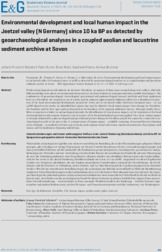Environmental development and local human impact in the Jeetzel valley (N Germany) since 10 ka BP as detected by geoarchaeological analyses in a coupled aeolian and lacustrine sediment archive at Soven
Tolksdorf, Friedrich, Johann; Turner, Falko; Nelle, Oliver; Peters, Swetlana; Brückner, Helmut, 2015: Environmental development and local human impact in the Jeetzel valley (N Germany) since 10 ka BP as detected by geoarchaeological analyses in a coupled aeolian and lacustrine sediment archive at Soven. In: E&G – Quaternary Science Journal; Vol.64, No.2, p.95-110, DOI: 10.3285/eg.64.2.04.
 |
Dokument öffnen: |
While archaeological records indicate an intensive Mesolithic occupation of dune areas situated along river valleys, relatively little knowledge exists about environmental interactions in the form of land-use strategies and their possible local impacts. The combination of geoarchaeological, chronological, geochemical and palaeoecological research methods and their application both on a Mesoltihic site situated on top of a dune and the adjacent palaeochannel sediments allows for a detailed reconstruction of the local environmental development around the Soven site in the Jeetzel valley (Northern Germany) since ~10.5 ka cal BP. Based on the results, we identified four phases that may be related to local human impact twice during the Mesolithic, the Neolithic and the Iron Ages and are discussed on the backdrop of the regional settlement history. Although nearby Mesolithic occupation is evident on archaeological grounds, the identification of synchronous impacts on the vegetation in the local environmental records remains tentative even in respect of the broad methodical spectrum applied. Vice versa, human impact is strongly indicated by palaeoecological and geochemical proxies during the Neolithic period, but cannot be connected to archaeological records in the area so far. A younger phase of human impact – probably consisting of seasonal livestock farming in the wetlands – is ascribed to the Iron Age economy and comprises local soil erosion, raised concentrations of phosphates and urease, and the facilitation of grazing related taxa.

